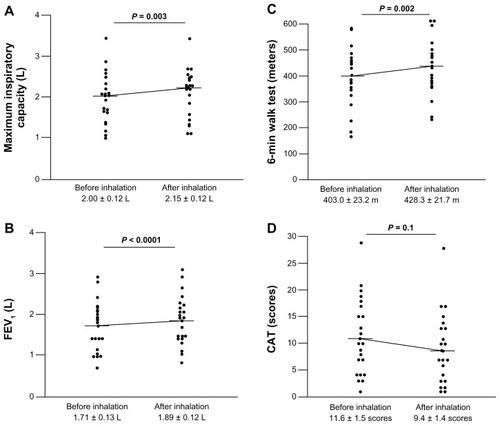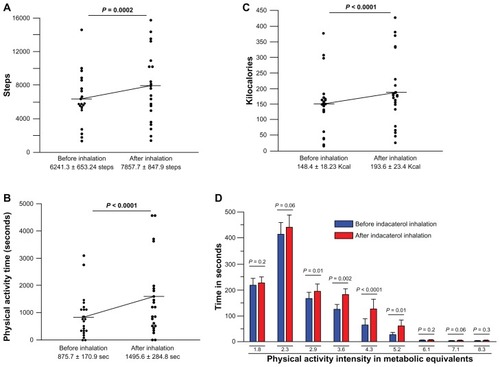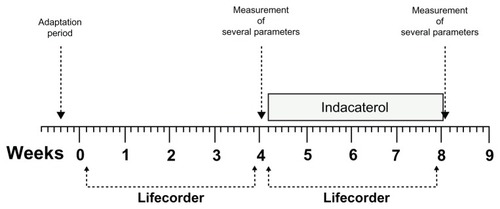Abstract
Background
The current mainstay of therapy for chronic obstructive pulmonary disease (COPD) is long-acting bronchodilators. To date, the effect of indacaterol, a β2-agonist, on activities of daily living in COPD patients is not well understood. The aim of this study was to evaluate the efficacy of indacaterol with regard to activities of daily living in patients with COPD.
Methods
In this nonrandomized open-label study, 23 patients with COPD were instructed to carry an accelerometer for 4 weeks without indacaterol therapy and then for another period of 4 weeks while receiving indacaterol therapy.
Results
The number of steps, duration of moderate or greater physical activity, and energy expenditure were significantly increased after treatment with indacaterol compared with baseline data in all patients with COPD; the metabolic equivalent of task was also significantly enhanced after treatment with indacaterol.
Conclusion
This study provides early evidence that indacaterol improves daily physical activity in patients with COPD.
Introduction
Chronic obstructive pulmonary disease (COPD) results from a chronic inflammatory process of the airways.Citation1 The prevalence of COPD is very high, and the disease affects more than 10% of subjects aged over 40 years worldwide, and it is predicted that COPD will be the third leading cause of death by 2020.Citation2 The main cause of the disease is cigarette smoking.Citation2 The inflammatory process predominantly affects the small airways, is characterized by infiltration of neutrophils, macrophages, and CD8+ T cells, and leads progressively to fibrosis of the small bronchioles and destruction of the alveolar walls and lung parenchyma architecture.Citation3 The functional consequences of these pathological changes are airflow limitation with air-trapping and dynamic hyperinflation, leading to reduced inspiratory capacity and increased end-expiratory lung volumes.Citation3 Therefore, patients with COPD complain generally of dyspnea, particularly during exercise.Citation2 This shortness of breath limits physical activity and worsens quality of life in these patients.
At present, there is no curative therapy for COPD, and the aim of treatment is to reduce symptoms and exacerbations and to improve quality of life.Citation1 Treatment includes bronchodilators, rehabilitation, and home oxygen therapy. Recent studies have shown that the inhaled long-acting bronchodilators are very effective for improving symptoms, exercise capacity, and quality of life, as well as for prevention of exacerbations.Citation4 The β2-agonist, indacaterol, is an ultra-long- acting bronchodilator with an established clinical efficacy and safety profile which needs to be administered only once daily.Citation5,Citation6 Indacaterol was approved for use in the clinic by the European Medicines Agency in 2009 and by the US Food and Drug Administration in 2011. Several clinical trials performed in patients with moderate to severe COPD have shown that indacaterol significantly improved symptoms, pulmonary function test results, and quality of life, and markedly reduced the use of rescue medication compared with a placebo control group.Citation7–Citation9 Recent studies suggest that indacaterol may also improve exercise endurance in patients with COPD, but its effect on daily physical activity in these patients is not well understood as yet.Citation10,Citation11
Physical activity refers to movement of the body produced by skeletal muscle contraction leading to energy expenditure.Citation12 The level of physical activity during routine daily life has recently been recognized to be an important outcome parameter when evaluating the therapeutic response in patients with COPD.Citation13–Citation17 Limited physical activity has been reported to be associated with more hospitalizations because of exacerbations, and markers of physical activity have been shown to predict mortality in patients with COPD.Citation18–Citation21 Several studies have validated the use of accelerometers for objective measurement of physical activity in patients with the disease.Citation15,Citation20,Citation22 In the present study, the effect of indacaterol on daily physical activity was evaluated in patients with COPD using a uniaxial accelerometer.
Materials and methods
Subjects
This study included 23 patients with COPD attending the outpatient department at Matsusaka Municipal Hospital. shows the anthropometry, clinical staging, and results of pulmonary function testing in these subjects. All of the patients were ex-smokers and not on active smoking cessation pharmacotherapy, and had stable disease with no exacerbations before the beginning or during the study. Patients who were physically unable to move and those receiving home oxygen therapy or pulmonary rehabilitation were excluded. Three patients had comorbid arterial hypertension and three had hyperuricemia. In total, 24 patients were included in the study but one was excluded because of contusions and a sprained ankle following a traffic accident. Among the 23 eligible patients, 14 were receiving tiotropium 18 μg/day (by Handihaler) while nine were receiving no therapy; thus, during the entire study period, 14 cases received treatment with tiotropium together with indacaterol and nine with indacaterol alone. None of the patients received steroids or rescue with short-acting β-agonists during the study.
Table 1 Baseline demographic data for patients with chronic obstructive pulmonary disease
The diagnosis of COPD was made according to the criteria of the American Thoracic Society.Citation1 Pulmonary function tests were performed using a volume-type spirometer (Super Spiro, Discom-21FX III; Chest Corporation, Tokyo, Japan). The 6-minute walk test (6MWT) and the COPD Assessment Test (CAT) were performed based on a protocol and criteria previously described.Citation23,Citation24 Informed consent was obtained from all subjects before entry into the study.
Study design
This was an open-label clinical trial with no randomization, no placebo group, and no blinding. To record physical activity, the patients were asked to carry a Lifecorder, a uniaxial accelerometry sensor (Suzuken Corporation, Nagoya, Japan),Citation25 fixed to their belts for 4 weeks without receiving indacaterol therapy and then for another period of 4 weeks while receiving 150 μg of inhaled indacaterol (). Physical activity before and after treatment with indacaterol was then compared. Before the trial was started, there was a period of adaptation during which each patient received instructions on how to fix and use the device correctly. Patients were instructed to fix the device every day upon waking and to remove it before going to sleep.
Statistical analysis
All data are expressed as the mean ± standard error of the mean. The difference between the means of two variables was assessed using the nonparametric Wilcoxon’s rank test. Statistical analyses were performed using the StatView 4.5 package for Macintosh (Abacus Concepts, Berkeley, CA). A P value less than 0.05 was considered to be statistically significant.
Results
Pulmonary function, 6MWT, and CAT
Forced expiratory volume in one second (FEV1) and 6MWT are important parameters when assessing the response to therapy in patients with COPD.Citation1 Comparing these parameters before and after treatment showed a significant increase in FEV1 and in maximum inspiratory capacity after 4 weeks of treatment with indacaterol (). Similarly, the distance walked during the 6MWT was significantly increased after treatment compared with that before starting indacaterol (). The CAT score also tended to decrease after treatment with indacaterol but this did not reach a statistically significant level ().
Figure 2 Response to indacaterol. Maximum inspiratory capacity (A), FEV1 (B), and 6MWT (C) improved significantly after 4 weeks of treatment with indacaterol. The CAT score (D) tended to decrease after treatment with indacaterol.
Abbreviations: 6MWT, six-minute walk test; CAT, COPD Assessment Test; FEV1, forced expiratory volume in one second.

Physical activity parameters
The Lifecorder was carried by all patients, and the number of steps, duration of moderate or higher degree exercise, energy expenditure, and metabolic equivalent of task were measured. The number of steps (), time in seconds of moderate or more activity (), and energy expenditure expressed in kilocalories () were significantly increased after treatment compared with baseline in all patients. The metabolic equivalent of task was also significantly improved after treatment with indacaterol compared with baseline data ().
Figure 3 Effect of indacaterol on physical activity parameters. Number of steps (A), duration of moderate or more exercise (B), energy expenditure (C) and metabolic equivalent of task (D) improved significantly after treatment with indacaterol in all patients.

Discussion
The results of this study show that the long-acting β2-agonist, indacaterol, significantly and effectively improved daily physical activity in patients with COPD and that the physical activity parameters recorded using the uniaxial accelerometry sensor are useful for monitoring the therapeutic response in this group of patients.
The mainstay of treatment for symptomatic improvement in patients with COPD is inhaled bronchodilators.Citation1 Of these, the ultra-long-acting β2-adrenoreceptor agonist, indacaterol, and the long-acting antimuscarinic, tiotropium bromide, have been shown to be very effective for reducing symptoms, to increase exercise tolerance, to reduce the frequency of exacerbations, and to improve quality of life test scores.Citation4 These drugs have a further advantage over previous long-acting bronchodilators, in that they can be used once daily, so are associated with fewer side effects.Citation4,Citation26,Citation27 In the present study, we focused on the β2-agonist, indacaterol, and evaluated whether it can improve exercise capacity and FEV1 in patients with COPD treated for 4 weeks, and our results showed that this agent significantly improved the results of lung function testing and exercise endurance as measured by the 6MWT.
One hurdle that needs to be overcome in the management of patients with COPD is the assessment of response to therapy in terms of physical activity during routine daily life. Recent studies have validated the use of several accelerometers in the assessment of the level of activity in COPD patients.Citation15,Citation21 The results reported have shown a significant association between a low level of physical activity as measured by accelerometers and increased mortality and morbidity from COPD.Citation21 In addition, less active patients are more likely to be hospitalized as a result of exacerbations.Citation20 To the authors’ knowledge, the efficacy of indacaterol in daily life activity has not been evaluated until now. In the present study, we used a novel accelerometer, the sensitivity and efficacy of which has been previously validated.Citation25 This novel accelerometer can measure several indicators of daily physical activity, including the number of steps, energy expenditure, and metabolic equivalent of task.Citation25 The device is easy to use, cost-effective, and can record data on a real-time basis every 4 seconds and over a lengthy period of time. We carried out a prospective and open clinical trial to assess whether indacaterol can improve daily physical activity in patients with COPD. The number of steps, energy expenditure, and metabolic equivalent of task were significantly increased in all patients after treatment with indacaterol, suggesting that this β2-agonist improves routine daily activity in patients with COPD.
Our study has several limitations, including its open nature, a small patient population, lack of a placebo control group, and no randomization. In addition, although the patients were-not asked or motivated to perform any exercise other than their normal or routine daily physical activity, they knew that they were receiving the drug during the second period of the study and therefore they could have been psychologically motivated or encouraged to perform better during their daily physical activity. However, to avoid some of these confounding factors, the patients were allowed to have an adaptation period during which they received training about how to use the device and about the performance of lung function tests.
In brief, this study provides early evidence that indacaterol improves daily activity in patients with COPD. However, a larger patient population and a placebo control group should be included in future studies to validate the present findings.
Acknowledgment
The authors are very grateful to Shinobu Taniguchi, Mayumi Asai, and Miyuki Kadomatsu for their kind assistance and cooperation with the completion of this work.
Disclosure
The authors report no conflicts of interest in this work.
References
- RabeKFHurdSAnzuetoAGlobal strategy for the diagnosis, management, and prevention of chronic obstructive pulmonary disease: GOLD executive summaryAm J Respir Crit Care Med200717653255517507545
- RycroftCEHeyesALanzaLBeckerKEpidemiology of chronic obstructive pulmonary disease: a literature reviewInt J Chron Obstruct Pulmon Dis2012745749422927753
- BarnesPJImmunology of asthma and chronic obstructive pulmonary diseaseNat Rev Immunol2008818319218274560
- TashkinDPFabbriLMLong-acting beta-agonists in the management of chronic obstructive pulmonary disease: current and future agentsRespir Res20101114921034447
- BeierJBeehKMLong-acting beta-adrenoceptor agonists in the management of COPD: focus on indacaterolInt J Chron Obstruct Pulmon Dis2011623724321814459
- McKeageKIndacaterol: a review of its use as maintenance therapy in patients with chronic obstructive pulmonary diseaseDrugs20127254356322356291
- CopeSZhangJWilliamsJJansenJPEfficacy of once-daily indacaterol 75 mug relative to alternative bronchodilators in COPD: a study level and a patient level network meta-analysisBMC Pulm Med2012122922732017
- RibeiroMChapmanKRComparative efficacy of indacaterol in chronic obstructive pulmonary diseaseInt J Chron Obstruct Pulmon Dis2012714515222419862
- RossiACentanniSCerveriIAcute effects of indacaterol on lung hyperinflation in moderate COPD: a comparison with tiotropiumRespir Med2011106849022035851
- MrozRMMinarowskiLChyczewskaEIndacaterol add-on therapy improves lung function, exercise capacity and life quality of COPD patientsAdv Exp Med Biol2013756232822836615
- O’DonnellDECasaburiRVinckenWEffect of indacaterol on exercise endurance and lung hyperinflation in COPDRespir Med20111051030103621498063
- CasaburiRActivity monitoring in assessing activities of daily livingCOPD2007425125517729069
- CazzolaMSegretiAStirpeEAppodiaMSenisLMateraMGEnergy expenditure and impact of bronchodilators in COPD patientsRespir Med20101041490149420471237
- LahaijeAJvan HelvoortHADekhuijzenPNHeijdraYFPhysiologic limitations during daily life activities in COPD patientsRespir Med20101041152115920346641
- PittaFTroostersTSpruitMAProbstVSDecramerMGosselinkRCharacteristics of physical activities in daily life in chronic obstructive pulmonary diseaseAm J Respir Crit Care Med200517197297715665324
- WaschkiBSpruitMAWatzHPhysical activity monitoring in COPD: compliance and associations with clinical characteristics in a multicenter studyRespir Med201210652253022118987
- WatzHWaschkiBMeyerTMagnussenHPhysical activity in patients with COPDEur Respir J20093326227219010994
- BenzoRPChangCCFarrellMHPhysical activity, health status and risk of hospitalization in patients with severe chronic obstructive pulmonary diseaseRespiration201080101820234126
- Garcia-RioFRojoBCasitasRPrognostic value of the objective measurement of daily physical activity in COPD patientsChest201214233834622281798
- PittaFTroostersTProbstVSSpruitMADecramerMGosselinkRPhysical activity and hospitalization for exacerbation of COPDChest200612953654416537849
- WaschkiBKirstenAHolzOPhysical activity is the strongest predictor of all-cause mortality in patients with COPD: a prospective cohort studyChest201114033134221273294
- WaschkiBSpruitMAWatzHPhysical activity monitoring in COPD: compliance and associations with clinical characteristics in a multicenter studyRespir Med201210652253022118987
- ATS Committee on Proficiency Standards for Clinical Pulmonary Function LaboratoriesATS statement: guidelines for the six-minute walk testAm J Respir Crit Care Med200216611111712091180
- MackayAJDonaldsonGCPatelARJonesPWHurstJRWedzichaJAUsefulness of the Chronic Obstructive Pulmonary Disease Assessment Test to evaluate severity of COPD exacerbationsAm J Respir Crit Care Med20121851218122422281834
- KumaharaHSchutzYAyabeMThe use of uniaxial accelerometry for the assessment of physical-activity-related energy expenditure: a validation study against whole-body indirect calorimetryBr J Nutr20049123524314756909
- DahlRChungKFBuhlREfficacy of a new once-daily long-acting inhaled beta2-agonist indacaterol versus twice-daily formoterol in COPDThorax20106547347920522841
- FeldmanGSilerTPrasadNEfficacy and safety of indacaterol 150 microg once-daily in COPD: a double-blind, randomised, 12-week studyBMC Pulm Med2010101120211002
